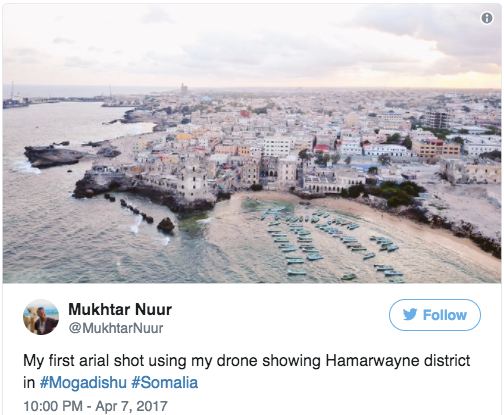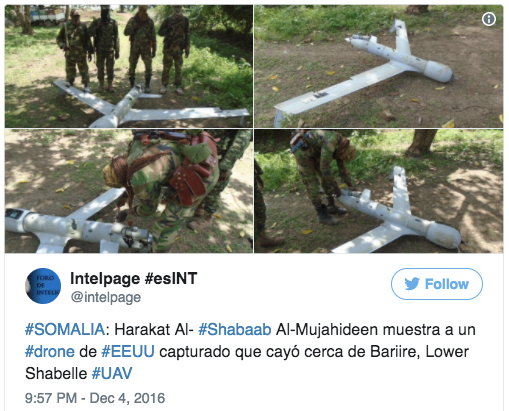Though residents in Somalia and Kenya were leery toward the use of drones, they acknowledged that their use in security could be useful under certain circumstances, according to the recent Navanti survey.
The informal Navanti survey, which took place from April to May 2017, asked residents in four locations in East Africa about their perceptions on the use of drones in their area. Respondents were from three cities in Somalia (Baidoa, Marka and Mogadishu) and from Lamu, Kenya. The respondents expressed mixed feelings about the use of unmanned aerial vehicles, recognizing their potential for increased security and for non-military purposes, but at the same time harboring resentment due to their role in airstrikes.




Drones, or more formally known as unmanned aerial vehicles (UAVs), were first employed in East Africa in 2007, when a U.S. Predator drone was reportedly the first of many to take off from U.S. base Camp Lemonnier in Djibouti, carrying out an attack against an al-Qaeda operative in Somalia. While these U.S. drones initially played a supporting role, both Predator and Reaper drones are now used directly to target radical militants in East Africa. Drones have become a key tool for the U.S. in the fight against violent extremist organizations such as al-Shabaab, which has turned central and southern Somalia into a base of operations that it uses to launch attacks on other areas.
In all four areas surveyed, respondents attested to having seen UAVs, the majority of which, they said, are used either to conduct airstrikes or monitor terrain to maintain security.
One respondent in Marka attested to having seen U.S. drones that had fallen and were then collected by al-Shabaab. In two such incidents in Marka, al-Shabaab posted pictures posing next to the downed UAVs.
The subject of UAVs in East Africa is still new and somewhat taboo. One respondent declined to respond to the survey due to fears of personal security. After several of its leaders died in airstrikes, al-Shabaab applied a ban on drones in all areas.
Al-Shabaab later allowed an interview with an Al Jazeera journalist, who wrote in 2016 that al-Shabaab had clarified the ban as, “Anything that flies that’s not a bird, we consider it our enemy.”
Most of the respondents acknowledged that UAVs have been helpful in the fight against violent extremist organizations, such as al-Shabaab, and were supportive of the U.S. and African Union Mission to Somalia’s (AMISOM’s) goals in East Africa.
>
“Both the U.S. and AMISOM use UAVs to conduct surveillance and reconnaissance to follow al-Shabaab movement, but the U.S. also conducts airstrikes,” said one resident of Marka.
“Drone strikes were used to weaken AS militants. For example, many of their leaders were taken out by using armed drone strikes.”
“This is good for the stabilization of Somalia.”
However, support among respondents for the mission to curb VEOs in East Africa did not translate to full support for UAVs in the area. Many respondents supported the use of drones for surveillance of VEOs but not as a tool for airstrikes, and called for more restrictions. Some were also afraid al-Shabaab may acquire drones and begin employing them.
>
“Civilian drones may get into the hands of al-Shabaab and they would start to use them in surveillance on the Somali National Army, AMISOM, or U.S. military force movements, or they could use them to collect intelligence information on military bases,” said a respondent in Baidoa.Al-Shabaab may try to fit bombs into the drones and may use them to target military bases, government institutions and officials as ISIS did in Iraq recently. … Therefore, I recommend that civilian drones in Somalia be restricted or controlled.”
Another respondent in Marka said that although drones as of now have not caused high civilian casualties in Somalia, that could change if other forces such as the Kenyan Defense Forces begin using them on a large scale.
>
“There are always repeated casualties as a result of air strikes mainly conducted by the KDF.”
Respondents in East Africa, more than other locations surveyed, noted the non-military use of smaller, commercial UAVs in their area, especially to film aerial footage for news and documentaries, which was generally seen in a positive light. One resident in Mogadishu attested to seeing drones regularly film for news media outlets.
>
“Drones have captured the beauty of our urban areas as well as the natural beauty of our landscape…For example, civilians have used drones to record videos of the farmland areas around the Shabelle and Juba rivers as well as beautiful beaches in Somalia, which were really amazing.”
Respondents still remain, however, very concerned about the potential for unchecked use of drones in East Africa.
In 2016, a drone disguised as a bird — that local reports eventually attributed to Somalia’s National Intelligence and Security Agency — was discovered after it had fallen from the sky in Mogadishu, leaving residents asking who was spying on whom and why.
>
“Even if they [drones] are to be used for civil purposes, they may violate the privacy and consent of individuals and could lead to controversy.”
Looking forward, despite support for the U.S.-AMISOM mission to target al-Shabaab in Somalia, increased UAV use by security forces could have an adverse effect on local sentiments, especially in the case of an escalation in airstrikes or civilian casualties.
About Navanti
Navanti researches socio-economic and political risk trends using a combination of in-house subject matter experts and hyper-local atmospherics reporting from local researchers in predominantly high-conflict zones across Africa, the Middle East, and Eurasia.

